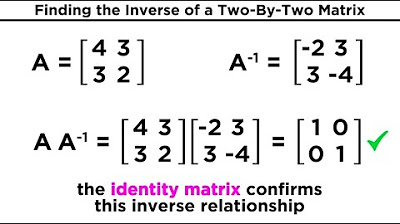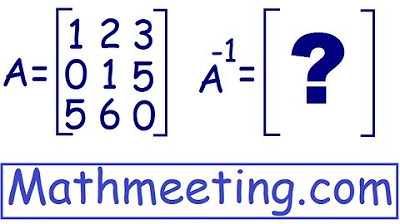Inverse of a 2x2 Matrix
TLDRThe video script presents a clear and concise tutorial on finding the inverse of a 2x2 matrix. It begins by defining a 2x2 matrix with elements 7, 2, 17, and 5, and then applies the formula for the inverse, which involves swapping the main diagonal elements and changing the signs of the off-diagonal elements, followed by dividing by the determinant. The script then verifies the inverse by multiplying the original matrix with its calculated inverse, resulting in the identity matrix. The process is repeated with a second matrix, confirming the concept of matrix inversion and its verification through matrix multiplication.
Takeaways
- 📌 The script explains how to find the inverse of a 2x2 matrix using a specific formula.
- 🔢 A 2x2 matrix is represented with elements a, b, c, and d, where 'a' is the top left, 'b' is top right, 'c' is bottom left, and 'd' is bottom right.
- 🎯 The formula for the inverse of a 2x2 matrix is given by 1/(ad-bc) multiplied by the matrix of elements d, -b, -c, and a.
- 👀 To find the inverse of matrix A with elements 7, 2, 17, and 5, replace a with 7, d with 5, b with 2, and c with 17 in the formula.
- 🧠 The inverse of matrix A is calculated to be 5, -2, -17, and 17, after simplifying the expression.
- 🔍 Confirmation of the inverse is done by multiplying the original matrix with its inverse, which should result in the identity matrix.
- 📐 The identity matrix for a 2x2 square matrix is represented as [1 0; 0 1].
- 🔄 The script also demonstrates the process of matrix multiplication to confirm the inverse.
- 🌟 Another example is given for matrix B with elements 8, 6, 5, and 4, showing how to find its inverse.
- 📝 The inverse of matrix B is calculated to be 2, -3, -5/2, and 4, after applying the formula and simplifying.
- 💡 The script concludes by showing that multiplying matrix B with its calculated inverse indeed results in the identity matrix, confirming the correctness of the inverse.
Q & A
What is the definition of a matrix inverse?
-A matrix inverse, often denoted as A^(-1), is a matrix that, when multiplied with the original matrix A, results in the multiplicative identity matrix. For a 2x2 matrix, the inverse is calculated using the formula 1/(ad - bc), with ad - bc being the determinant of the matrix, and the inverse matrix having elements d, -b, -c, and a.
What are the elements of the given 2x2 matrix A?
-The elements of matrix A are 7, 2, 17, and 5, arranged in the order [a, b; c, d] as follows: [[7, 2], [17, 5]].
How is the inverse of matrix A calculated?
-The inverse of matrix A is calculated by substituting the elements into the formula 1/(ad - bc), resulting in 1/(7*5 - 2*17). The elements of the inverse matrix are then [d, -b; -c, a], which after substitution become [5, -2; -17, 7].
How can you confirm that a matrix is indeed the inverse of another matrix?
-To confirm that a matrix is the inverse of another, you multiply the original matrix by its supposed inverse. If the result is the multiplicative identity matrix, then the given matrix is indeed the inverse. For a 2x2 matrix, the identity matrix is [[1, 0], [0, 1]].
What is the multiplicative identity matrix for a 2x2 matrix?
-The multiplicative identity matrix for a 2x2 matrix is [[1, 0], [0, 1]]. When any matrix is multiplied by this identity matrix, the original matrix is returned unchanged.
What are the elements of matrix B?
-The elements of matrix B are 8, 6, 5, and 4, arranged in the order [a, b; c, d] as follows: [[8, 6], [5, 4]].
How is the inverse of matrix B calculated?
-The inverse of matrix B is calculated using the same formula as for matrix A, 1/(ad - bc). After substitution, the inverse matrix has elements [d, -b, -c, a], which become [4, -6, -5, 8] after using the elements of matrix B.
What is the determinant of matrix B?
-The determinant of matrix B is calculated as ad - bc, which is 8*4 - 6*5 = 32 - 30 = 2.
How can you show that two matrices are inverses of each other?
-To show that two matrices are inverses of each other, you multiply them together and demonstrate that the result is the multiplicative identity matrix for the same size. If the product is the identity matrix, then the two matrices are indeed inverses.
What is the result of the matrix multiplication of matrix A and its inverse?
-The result of the matrix multiplication of matrix A and its inverse is the multiplicative identity matrix for a 2x2 matrix, which is [[1, 0], [0, 1]].
What is the result of the matrix multiplication of matrix B and its inverse?
-The result of the matrix multiplication of matrix B and its inverse is also the multiplicative identity matrix for a 2x2 matrix, which is [[1, 0], [0, 1]].
Why is it important to verify that two matrices are inverses of each other?
-Verifying that two matrices are inverses of each other is important because it confirms that the operations you performed to find the inverse were correct. It also ensures that the matrices will cancel each other out when multiplied, which is a fundamental property of inverse matrices.
Outlines
📚 Understanding the Inverse of a 2x2 Matrix
This paragraph introduces the concept of finding the inverse of a 2x2 matrix, using a specific example to illustrate the process. The matrix A with elements 7, 2, 17, and 5 is used to demonstrate the calculation. The formula for the inverse is explained, which involves swapping the main diagonal elements (a and d), changing the signs of the off-diagonal elements (b and c), and then dividing by the determinant (ad - bc). The calculation proceeds step by step, showing how to replace the variables with actual numbers and perform the necessary arithmetic to arrive at the inverse matrix. The paragraph concludes with a verification method, explaining that the product of a matrix and its inverse should result in the identity matrix. The example confirms this by multiplying the original matrix A with its calculated inverse and showing that the resulting matrix matches the identity matrix, thus validating the correctness of the inverse.
🔍 Confirming the Inverse and Applying it to Another Matrix
This paragraph continues the discussion on matrix inversion by confirming the correctness of the previously calculated inverse for matrix A and then applying the concept to a new matrix B. The elements of matrix B (8, 6, 5, and 4) are used to derive its inverse using the same formula as before. The calculation involves the same process of swapping and sign-changing, followed by the division by the determinant. The resulting inverse matrix for B is presented, and the verification process is explained. The paragraph then demonstrates the multiplication of matrix B with its inverse, showing that the product indeed results in the identity matrix, confirming the inverse's validity. This step-by-step explanation reinforces the method of finding and verifying the inverse of a 2x2 matrix.
Mindmap
Keywords
💡Matrix
💡Inverse Matrix
💡Elements
💡Formula
💡Identity Matrix
💡Multiplicative Identity
💡Confirm
💡Linear Equations
💡Row and Column
💡Multiply
💡Scalar
Highlights
The method for finding the inverse of a 2x2 matrix is explained.
Matrix A with elements 7, 2, 17, and 5 is used as an example.
The formula for the inverse involves elements a, b, c, and d from the matrix, and their interrelations.
The inverse of Matrix A is calculated to be 5, -2, -17, and 17.
The process of confirming the inverse is by multiplying the original matrix with its calculated inverse.
The identity matrix for a 2x2 square matrix is represented as 1 0 0 1.
Matrix B with elements 8, 6, 5, and 4 is used as a second example.
The inverse of Matrix B is calculated using the same method, resulting in 2, -3, -5/2, and 4.
Confirmation of Matrix B's inverse is done by multiplying it with the original Matrix B and showing the result is the identity matrix.
The detailed calculation of the product of Matrix A and its inverse confirms the multiplicative identity.
The detailed calculation of the product of Matrix B and its inverse also confirms the multiplicative identity.
The method can be used to quickly determine the inverse of any 2x2 matrix.
The process of finding the inverse is a fundamental concept in linear algebra.
Understanding matrix inversion is crucial for various applications in fields like computer graphics, physics, and engineering.
The explanation provides a step-by-step guide that is easy to follow for those familiar with matrix operations.
The use of negative values in the calculation process is highlighted, which is typical in matrix inversion.
The concept of the multiplicative identity matrix is introduced and its structure is explained.
The JSON format is used to structure the highlights, which is a common data interchange format in programming.
The example matrices used in the transcript are relatively small, making the calculations manageable and the explanations clear.
The transcript demonstrates the practical application of theoretical concepts in linear algebra.
Transcripts
Browse More Related Video

Inverse Matrices and Their Properties

PreCalculus - Matrices & Matrix Applications (21 of 33) Using the Determinant to Find the Inverse

Inverse of 3x3 matrix

Idea behind inverting a 2x2 matrix | Matrices | Precalculus | Khan Academy

How to Invert Matrices - Exercises (Step by Step)

Inverse of a 3x3 Matrix
5.0 / 5 (0 votes)
Thanks for rating: